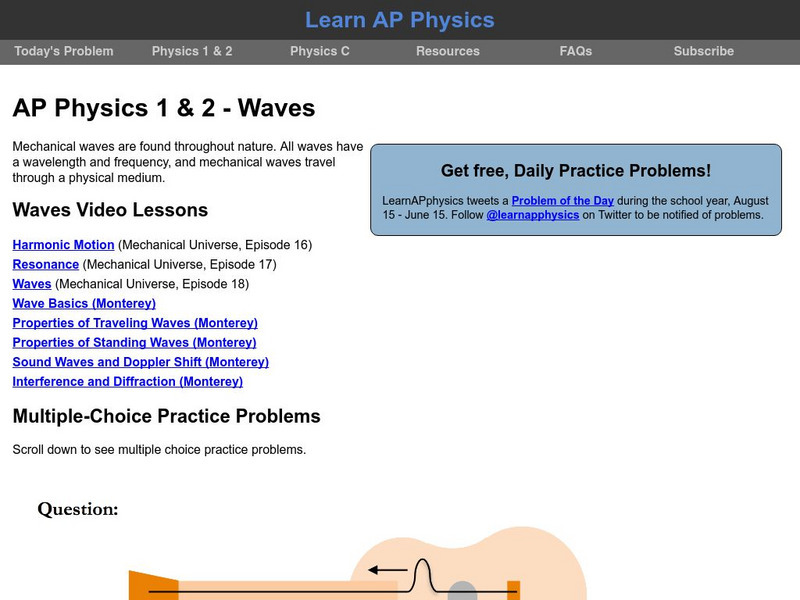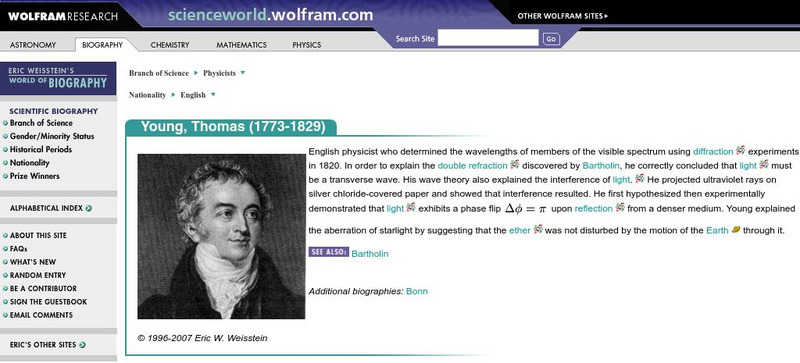Physics Classroom
The Physics Classroom: Refraction/ray Model of Light: Light Dispersion Prisms
A tutorial which introduces students to the dispersion of light in more detail, and investigates the reasons why different frequencies of light bend or refract different amounts when passing through the prism.
Physics Aviary
Physics Aviary: Diffraction Lab
This lab is designed to allow students to look at the factors affecting the angle at which constructive interference occurs for waves passing through a two slit diffraction grating. This video helps explain the problem:...
Physics Aviary
Physics Aviary: Em Spectrum Lab
This lab is designed to allow students to look at the factors affecting the location of different colors formed by diffraction grating.
University of St. Andrews (UK)
University of St. Andrews: Thomas Young
A short biographical sketch of Thomas Young's (1863- 1942) life as a mathematician and a scientist. Gives an account of his birth and the final years of his life.
CK-12 Foundation
Ck 12: Physics Simulation: Marina
[Free Registration/Login Required] Learn about the interference and diffraction patterns that result when a wave passes through one or two thin openings using this interactive simulation. A PDF worksheet and a video tutorial are also...
Pennsylvania State University
Kettering University: Vibration & Waves
A short tutorial providing general information about waves, their categories, properties and behaviors. Includes several animations and some practice questions with answers.
BBC
Bbc: Gcse Bitesize: Why Do Scientists Think That Light and Sound Are Waves?
Light travels as transverse waves and can travel through a vacuum. Sound travels as longitudinal waves and needs to travel through a solid, liquid or gas. Read about the properties of light and of sound, and learn the differences between...
CK-12 Foundation
Ck 12: Physics: Wave Optics Study Guide
A study guide for concepts related to wave optics.
Science Buddies
Science Buddies: Rainbow Candy
Make your own rainbow candy in this fun STEM activity. You will do it without using any food coloring. Instead, you will use a light-bending phenomenon called diffraction.
Cosmo Learning
Cosmo Learning: Physics Iii: Vibrations and Waves
A collection of video lectures from a physics course focusing on vibration and waves taught at the Massachusetts Institute of Technology. The course overviews topics dealing with mechanical vibration and waves with twenty-three lectures....
Ducksters
Ducksters: Physics for Kids: Wave Behavior
Kids learn about the behavior of waves in the science of physics including reflection, refraction, diffraction, polarization, absorption, and interference.
Learn AP Physics
Learn Ap Physics: Physics B: Waves
A site dedicated to help students prepare for the AP Physics B test. This specific site reviews waves including traveling waves, standing waves, resonance, speed of electromagnetic waves, Doppler shift, Doppler effect, interference,...
Synopsys
Synopsys: A Gentle Intro to Optical Design: Why Is the Sky Blue?
Discusses Rayleigh scattering in plain language and attributes the blueness of the skies to this phenomenon. Discussion of scattering is just one topic of many on this lengthy page of optical topics.
Optical Society
Optical Society of America: Optics for Kids: Diffraction Between Wax Blocks
An activity to demonstrate how light behaves when encountering an obstacle, in this case, wax blocks placed in a ripple tank. Includes an explanation of the diffraction that occurs.
Boston University
Bu: Optics Demonstrations: Diffraction
Short descriptions and graphics of three demonstrations which illustrate the diffraction phenomenon. Suitable as a supplement for a teacher lesson plan or as an idea-generator for a student project.
Wolfram Research
Wolfram Science World: Young, Thomas
This site from ScienceWorld provides a very short but factual biographical sketch of Thomas Young (1773-1829 CE) and describes his most notable scientific discoveries and contributions. Links are also provided throughout for additional...










